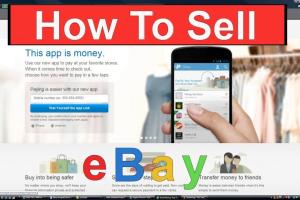Mastering eBay: The Comprehensive Guide to Selling Successfully

-
Quick Links:
- 1. Introduction to Selling on eBay
- 2. Setting Up Your eBay Account
- 3. Understanding eBay Fees
- 4. Researching and Sourcing Products
- 5. Creating Compelling Listings
- 6. Shipping and Fulfillment
- 7. Promoting Your Listings
- 8. Managing Customer Relationships
- 9. Analyzing Your Sales Performance
- 10. FAQs
1. Introduction to Selling on eBay
Selling on eBay can be a lucrative venture. With millions of active buyers, eBay offers a unique platform for individuals and businesses to sell a wide variety of items. This guide aims to provide you with the tools and knowledge you need to succeed in the eBay marketplace.
2. Setting Up Your eBay Account
To sell on eBay, you need to create a seller account. Here’s a step-by-step guide:
- Visit the eBay website and click on "Register".
- Fill in your personal information, including your email and password.
- Choose between a personal or business account.
- Verify your email address.
- Link a payment method (PayPal or credit card) for receiving payments.
Account Verification
Once your account is set up, eBay may require additional verification to ensure the security of transactions. This can include linking a bank account or providing identification.
3. Understanding eBay Fees
Before you start selling, it’s crucial to understand eBay’s fee structure:
- Insertion Fees: Charged when you list an item.
- Final Value Fees: A percentage of the total amount of the sale, including shipping.
- PayPal Fees: If you use PayPal, be aware of additional transaction fees.
For detailed fee structures, refer to eBay's official fees overview.
4. Researching and Sourcing Products
Successful selling starts with choosing the right products. Here are some strategies for effective product research:
- Market Trends: Use eBay's trending lists to see what’s popular.
- Competitor Analysis: Review listings from successful sellers to identify best practices.
- Sourcing Options: Consider wholesale suppliers, garage sales, or liquidation sales for sourcing products.
Case Study: Successful eBay Sellers
A detailed case study of a seller who specializes in vintage clothing shows that understanding niche markets can lead to substantial profits. By focusing on a specific category, they built a loyal customer base.
5. Creating Compelling Listings
Your listings are your storefront on eBay. To create compelling listings, follow these tips:
- High-Quality Images: Use clear, high-resolution images from multiple angles.
- Descriptive Titles: Include keywords that potential buyers may search for.
- Detailed Descriptions: Provide all necessary information, including size, condition, and brand.
SEO Optimization for Listings
To rank higher in eBay search results, utilize relevant keywords in your titles and descriptions. Tools like Google Keyword Planner can help you identify the best keywords for your products.
6. Shipping and Fulfillment
Shipping is a critical aspect of selling on eBay. Here’s how to streamline the process:
- Offer Multiple Shipping Options: Provide buyers with choices, such as standard and expedited shipping.
- Consider Free Shipping: Listings with free shipping often attract more buyers.
- Use eBay’s Shipping Tools: eBay offers discounted shipping labels which can save you money.
7. Promoting Your Listings
To boost sales, consider these promotional strategies:
- eBay Promotions: Use eBay's promotional tools to create discounts and sales.
- Social Media: Share your listings on platforms like Facebook and Instagram.
- Utilize eBay Ads: Invest in eBay’s advertising options to reach more buyers.
8. Managing Customer Relationships
Building strong relationships with customers can lead to repeat business. Here are some strategies:
- Prompt Communication: Respond quickly to inquiries and concerns.
- Request Feedback: Encourage buyers to leave positive feedback after a successful transaction.
- Handle Disputes Professionally: Address any issues amicably to maintain your seller rating.
9. Analyzing Your Sales Performance
Regularly reviewing your sales data can help you identify trends and areas for improvement. Use eBay's analytics tools to track:
- Sales volume
- Customer feedback
- Return rates
10. FAQs
- 1. What can I sell on eBay?
- You can sell almost anything, including electronics, clothing, home goods, and collectibles.
- 2. How do I price my items?
- Research similar items on eBay to determine competitive pricing.
- 3. How should I handle returns?
- Establish a clear return policy and communicate it in your listings.
- 4. Can I sell internationally?
- Yes, eBay allows you to sell to buyers worldwide.
- 5. What are eBay’s selling limits?
- New sellers may have limits on the number of items they can list initially, which can be increased over time.
- 6. How do I get paid?
- Payments are typically processed through PayPal or eBay’s managed payments system.
- 7. What if I have a negative feedback?
- Address the issue promptly and professionally; you can also respond to feedback publicly.
- 8. How can I improve my seller rating?
- Focus on great customer service, prompt shipping, and maintaining high-quality listings.
- 9. What are the best times to list items?
- Research shows that weekends and evenings tend to have higher traffic on eBay.
- 10. Can I sell used items?
- Yes, eBay is a popular platform for both new and used items.
Random Reads
- How to make an arrow in runescape
- Increase microphone volume android
- Improve search engine optimization
- How to take cover in gta 5
- Capture still image video iphone ipad
- How to build a fake wall
- How to build a door in minecraft
- How to add watermark microsoft word
- How to add video to powerpoint mac
- How to repair mercury thermometer